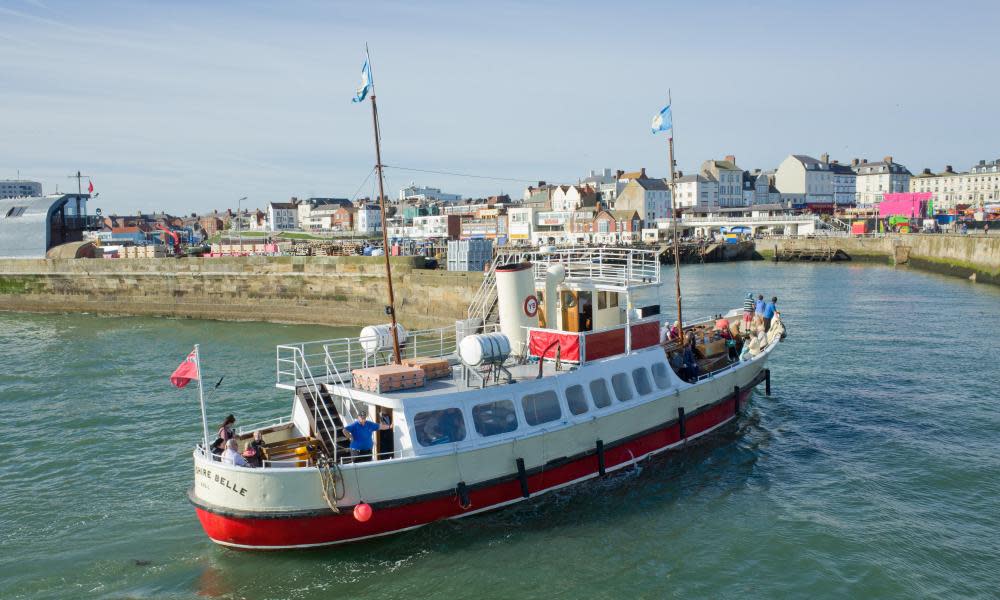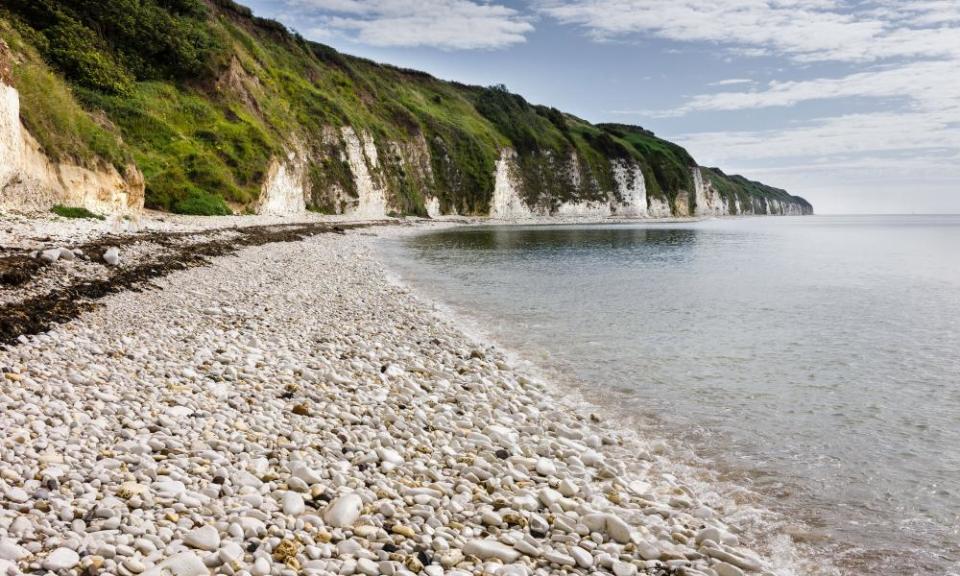Seabirds, lobsters and rock: a car-free trip to Bridlington, east Yorkshire

The cliffs are alive with seabirds. Every rocky ledge is lined with gulls and guillemots. The air smells of fish and guano and is busy with flying birds, including huge gannets with nicotine-yellow heads and two-metre wingspans.
Among an unearthly cacophony of cries, like the soundtrack from a nature documentary, I can identify only kittiwakes – named for their distinctive call. The crumbling coast north of Bridlington, sea-carved into huge spires and caves, is home to half a million birds between March and October.

Getting here was an adventure. Sea mist and rough waves grounded the Yorkshire Belle’s afternoon cruise to the cliffs (£20 adult/£10 child for 2½-hour Bempton Cliffs cruise), leaving me stranded on the foggy harbourside in Bridlington. I catch the open-top bus instead to Flamborough Head (£5 all day). Today it’s actually an ordinary bus.
The driver tells me cheerfully that the open-topper’s at the garage, but should be fine for the school hols, when it runs every day. From Flamborough’s lighthouses, I walk out of the mist along the flowery cliffs to North Landing. Hourly bus 14 is just arriving, but the summer evening is long and I keep going to Bempton Cliffs, an RSPB reserve 1¼ miles from Bempton station. Train is the quickest way to arrive car-free (£3.90 return, 8 mins from Bridlington), but the five-mile walk from Flamborough is a nature-spotter’s paradise: the flash of pink orchids among the vetch and silverweed, a glimpse of orange feet on the monochrome cliff face – my first puffin.

“There’s an albatross back there,” says a passing walker. So I hurry on, like a harmless ancient mariner, trying to shoot birds in the fading light with my inadequate camera. Birders have gathered at Staple Newk viewpoint. They show me where the albatross is sitting on a rocky arch, thousands of miles off course from the South Atlantic, and point out its relatives, the fulmars, which I’d thought were big grey gulls. As I head for the station, a barn owl is hunting soundlessly over the meadow.
Bridlington claims to be the lobster capital of Europe, and I eat crisp-battered lobster bites on the quayside
Thirty years ago, studying for a PGCE at Hull university, I did my teaching practice in the brick Victorian buildings of Bridlington School. I remember the train ride from Doncaster past estuary, marsh and distant wooded wolds. The glass-roofed Edwardian ticket hall at Bridlington station is bright with begonias and pink petunias, spilling out of wooden tubs and hanging baskets. The plaza outside is one of several areas being re-landscaped with new lighting and benches. Regenerating, like a Time Lord, the town is starting to look a bit different, but is basically the same.
Ten minutes’ walk from the railway station and three minutes from sandy South Beach, the Ivanhoe guesthouse is one of dozens of B&Bs among Bridlington’s semi-detached streets. It is conscientiously hosted by Wendy and Ray, who offer big breakfasts, clean rooms, and earplugs in case the seagulls disturb you (two-night minimum, doubles from £60 room-only, or £73 B&B).
The driver of the bus I catch next morning, from the end of the road, has a huge collection of rubber ducks around his cab. I’m heading for Burton Agnes Hall, a Tudor stately home in the countryside, which Simon Jenkins calls: “the perfect English house, embodying the climax of the final great age of domestic architecture” (entry £12/£7, 10% discount for people arriving by bus). The coast-to-coast Way of the Roses cycle route from Bridlington to Morecambe goes right past the hall, which has cycle racks. Alternatively, it’s a 15-minute ride on buses 121 or 45. I sit at an upper-deck table, charge my phone and watch the fields (and the school where I once taught) roll past.
Although I aimed to be back in town for lunch, nearly four hours later I am still at Burton Agnes, eating an outdoor wood-fired pizza with herbs and tomatoes from the gardens. Every corner of the grounds is worth exploring, from the vaulted undercroft of a Norman manor house to the luxuriant colour-themed garden rooms with giant games of chess and draughts. Full-blown roses are rambling over wooden arches and the walled garden is fragrant with chamomile, meadowsweet and lavender. There are impressionist paintings, Elizabethan ceilings, Chinese lacquered walls, a jungle garden with thickets of bamboo, waterlilies on the pond, and an old church with box pews.
Related: Whale-watching boom attracts new day trippers to Yorkshire
Back on the beach, it’s a sunny afternoon and I have a swim before tea at the art deco Bridlington Spa, a multi-purpose venue with a magnificent Edwardian theatre, ballroom and a cafe, remodelled in 2017, which has views across the sands outside to the (currently) blue ocean. Scone of the day is Rocky Road, a fruity, chocolatey, marshmallow-topped mountain that needs a whole pot of tea to go with it.
Next morning, I catch the Land Train along the revamped seafront to Sewerby Hall, a Georgian mansion that packs several attractions into its 20 hectares (50 acres): there are penguins, pygmy goats and guinea pigs in the zoo, monkey puzzles and weeping beeches in the pleasure gardens, four-posters upstairs and copper pots in the kitchen (entry £6.40/£4.40). My favourite corner is the rose garden, where rain has bedraggled the blooms but brought out the scent.
I walk a mile along the cliffs outside and find a hidden beach in the woods of Danes Dyke, a nature reserve with a fern-filled ravine and prehistoric earthworks. Looping back to Sewerby Hall on a footpath over the golf course, I catch the Land Train into town and get off near the waterside big wheel.

A stroll round the harbour, with its maritime trail and museum, passes mud flats with wading birds and quayside stacks of lobster pots. Bridlington is the UK’s biggest shellfish port and claims to be the lobster capital of Europe. I eat crisp-battered lobster bites at quayside Salt on the Harbour (£12.95) and gaze out to sea over fishing boats.
This is quintessential English seaside. There are dodgems, waltzers, striped rock, the smell of frying doughnuts and crabbing under the pier. There are dozens of ice-cream flavours and more than 20 fish & chip shops, fuelling that age-old waterfront war between gulls and chip-eaters. There’s even a gull on the station platform as I get on the train to head home, speeding south past the gothic minster at Beverley and west along the Humber.
• Train travel was provided by Northern. Direct trains to Bridlington take 45 minutes from Hull, 1½ hours from Doncaster, 2 hours from Sheffield or York (less via Seamer) and advance tickets start from £7.50 each way. For more info about the area, see visiteastyorkshire.co.uk

